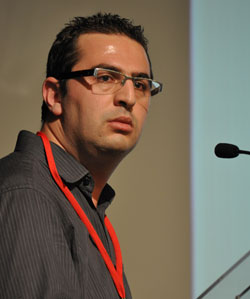Surveillance of microbiological contamination in a CAZ devoted to the reconstitution of cytotoxics
9 October 2011
N. Bouzina, M. Desbourdes, M. Montana, F. Peyron, M. Bues-Charbit Oncopharma Nord- hôpital nord, chemin des bourrely,13015 marseille, tel 04 91 96 89 89

Introduction
The reconstitution of cytotoxics (sterile preparations involving toxic risk) imposes special requirements to be respected to reduce the risks of microbial contamination in particular.
To this purpose, manufacturing is conducted in Controlled Atmosphere Zones (CAZ) that have to be covered by regular surveillance of the air and surfaces to ensure in particular that there is no microbiological contamination (Manufacturing Best Practices, Nov. 2007).
In this CAZ, cytotoxic reconstitution is conducted in isolators installed in class B rooms (ISO 5, Standard ISO 14-644). This class with its restrictions is imposed by presence in the same area of a laminar flow hood.
Retrospective analysis of the results of microbiological inspections conducted monthly by the Operational Hygiene Team (OHT) within the reconstitution unit and collected over a year showed recurrent contamination of the air and surfaces at two specific points.
Following these observations, a study of CAZ contamination intended to identify the origin of microbiological contamination was performed.
Equipment and Methods
- Analysis of the results of monthly microbiological inspections of the CRU conducted by the OHT, collected over a period of one year (January 2010 to January 2011).
- Implementation of a dedicated study intended to highlight the origin of microbiological contaminations: study conducted over a period of 2 days a week for 2 weeks and including successive samplings at 7.30 am, 8.30 am, 11.00 am, 1.00 pm and 5.00 pm.
- The sampling procedure required the use of:
- An aerobiocollector and trypticase type contact agars for air sampling.
- Trypticase type contact agars for surface sampling.
Results and Discussion
- Increase in the levels of air and surface contamination during the day
- Contamination of benches by the CRU personnel.
- Insufficient air renewal as compared with the number of people present.
- Net reduction in positive surface sampling after cleaning.
- Effective cleaning.
- Observation of a greater number of positive samples since increased activity relating to the opening of an oncology department and that involved a greater number of technicians working in the CRU.
- No positive sampling was observed inside the isolators.
Conclusion
- Need to adapt premises to growth in activity.
- work again to raise awareness of staff as to rules of hygiene to limit contaminations within the CRU